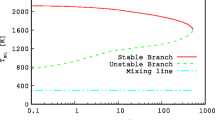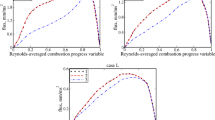Abstract
The effects of global Lewis number Le on the statistical behaviour of the unclosed terms in the transport equation of the Favre-filtered scalar dissipation rate (SDR) Ñ c have been analysed using a Direct Numerical Simulation (DNS) database of freely propagating statistically planer turbulent premixed flames with Le ranging from 0.34 to 1.2. The DNS data has been explicitly filtered to analyse the statistical behaviour of the unclosed terms in the SDR transport equation arising from turbulent transport T 1, density variation due to heat release T 2, scalar-turbulence interaction T 3, reaction rate gradient T 4, molecular dissipation (−D 2) and diffusivity gradients f(D) in the context of Large Eddy Simulations (LES). It Le has significant effects on the magnitudes of T 1, T 2, T 3, T 4, (−D 2) and f(D). Moreover, both qualitative and quantitative behaviours of the unclosed terms T 1, T 2, T 3, T 4, (−D 2) and f(D) are found to be significantly affected by the LES filter width Δ, which have been explained based on a detailed scaling analysis. Both scaling analysis and DNS data suggest that T 2, T 3, T 4, (−D 2) and f(D) remain leading order contributors to the SDR \(\tilde {{N}}_{c} \) transport for LES. The scaling estimates of leading order contributors to the SDR \(\tilde {{N}}_{c} \) transport has been utilised to discuss the possibility of extending an existing SDR model for Reynolds Averaged Navier Stokes (RANS) simulation for SDR \(\tilde {{N}}_{c} \) closure in the context of LES of turbulent premixed combustion.
Similar content being viewed by others
References
Bray, K.N.C.: Turbulent flows with premixed reactants. In: Libby, P.A., Williams, F.A. (eds.) Turbulent Reacting Flows, pp 115–183. Springer, New York, Berlin, Heidelberg (1980)
Chakraborty, N., Champion, M., Mura, A., Swaminathan, N.: Scalar dissipation rate approach to reaction rate closure, 1st edn. In: Swaminathan, N., Bray, K.N.C. (eds.) Turbulent Premixed Flame, pp 76–102. Cambridge University Press, Cambridge (2011)
Chakraborty, N., Cant, R.S.: Effects of Lewis number on flame surface density transport in turbulent premixed combustion. Combust. Flame 158, 1768 (2011)
Dunstan, T., Minamoto, Y., Chakraborty, N., Swaminathan, N.: Scalar dissipation rate modelling for large eddy simulation of turbulent premixed flames. Proc. Combust. Inst. 34, 1193–1201 (2013)
Chakraborty, N., Swaminathan, N.: Effects of Lewis number on scalar dissipation transport and its modeling implications for turbulent premixed combustion. Combust. Sci. Tech. 182, 1201–1240 (2010)
Chen, J.H., Choudhary, A., De Supinski, B., DeVries, M., Hawkes, E.R., Klasky, S., Liao, W.K., Ma, K.L., Mellor-Crummey, J., Podhorski, N., Sankaran, R., Shende, S., Yoo, C.S.: Terascale direct numerical simulations of turbulent combustion using S3D. Comput. Sci. Discov. 2, 015–001 (2009)
Sivashinsky, G.I.: Diffusional-thermal theory of cellular flames. Combust. Sci. Tech. 16, 137–146 (1977)
Clavin, P., Williams, F.A.: Effects of molecular diffusion and thermal expansion on the structure and dynamics of turbulent premixed flames in turbulent flows of large scale and small intensity. J.Fluid Mech. 128, 251–282 (1982)
Libby, P.A., Linan, A., Williams, F.A.: Strained premixed laminar flames with non-unity Lewis numbers. Combust. Sci. Tech. 34, 257–293 (1983)
Abdel-Gayed, R.G., Bradley, D., Hamid, M., Lawes, M.: Lewis number effects on turbulent burning velocity. Proc. Combust. Inst. 20, 505–512 (1984)
Ashurst, W.T., Peters, N., Smooke, M.D.: Numerical simulation of turbulent flame structure with non-unity Lewis number. Combust. Sci. Tech. 53, 339–375 (1987)
Haworth, D.C., Poinsot, T.J.: Numerical simulations of Lewis number effects in turbulent premixed flames. J. Fluid Mech. 244, 405–436 (1992)
Rutland, C., Trouvé, A.: Direct Simulations of premixed turbulent flames with nonunity Lewis numbers. Combust. Flame 94, 41–57 (1993)
Trouvé, A., Poinsot, T.: The evolution equation for flame surface density in turbulent premixed combustion. J. Fluid Mech. 278, 1–31 (1994)
Chakraborty, N., Cant, R.S.: Influence of Lewis number on curvature effects in turbulent premixed flame propagation in the thin reaction zones regime. Phys. Fluids 17, 105105 (2005)
Chakraborty, N., Klein, M.: Influence of Lewis number on the Surface Density Function transport in the thin reaction zones regime for turbulent premixed flames. Phys. Fluids 20, 065102 (2008)
Han, I., Huh, K.H.: Roles of displacement speed on evolution of flame surface density for different turbulent intensities and Lewis numbers for turbulent premixed combustion. Combust. Flame 152, 194–205 (2008)
Chakraborty, N., Klein, M., Swaminathan, N.: Effects of Lewis number on reactive scalar gradient alignment with local strain rate in turbulent premixed flames. Proc. Combust. Inst. 32, 1409–1417 (2009)
Chakraborty, N., Cant, R.S.: Effects of Lewis number on scalar transport in turbulent premixed flames. Phys. Fluids. 21, 035110 (2009)
Chakraborty, N., Cant, R.S.: Effects of Lewis number on turbulent scalar transport and its modelling in turbulent premixed flames. Combust. Flame 156, 1427–1444 (2009)
Chakraborty, N., Cant, R.S.: Physical insight and modelling for Lewis number effects on turbulent heat and mass transport in turbulent premixed flames. Numer. Heat Transf. A 55(8), 762–779 (2009)
Chakraborty, N., Swaminathan, N.: Effects of Lewis number on scalar variance transport in turbulent premixed flames. Flow Turb. Combust. 87, 261–292 (2011)
Boger, M., Veynante, D., Boughanem, H., Trouvé, A.: Direct Numerical Simulation analysis of flame surface density concept for large Eddy simulation of turbulent premixed combustion. Proc. Combust. Inst. 27, 917–925 (1998)
Charlette, F., Meneveau, C., Veynante, D.: A power-law flame wrinkling model for LES of premixed turbulent combustion. Part I: non-dynamic formulation and initial tests. Combust. Flame 131, 159–180 (2002)
Mizomoto, M., Asaka, S., Ikai, S., Law, C.K.: Effects of preferential diffusion on the burning intensity of curved flames. Proc. Combust. Inst. 20, 1933–1940 (1984)
Peters, N.: Turbulent Combustion. 1st edn. Cambridge University Press, Cambridge (2000)
Poinsot, T., Echekki, T., Mungal, M.: A study of the laminar flame tip and implications for turbulent premixed combustion. Combust. Sci. Tech. 81(1–3), 45–73 (1992)
Louch, D.S., Bray, K.N.C.: Vorticity in unsteady premixed flames: vortex pair-Premixed flame interactions under imposed body forces and various degrees of heat release and laminar flame thickness. Combust. Flame 125, 1279–1309 (2001)
Treurniet, T.C., Nieuwstadt, F.T.M., Boersma, B.J.: Direct numerical simulation of homogeneous turbulence in combination with premixed combustion at low mach number modeled by the G-equation. J. Fluid Mech. 565, 25–62 (2006)
Jenkins, K.W., Cant, R.S.: Curvature effects on flame kernels in a turbulent environment. Proc. Combust. Inst. 29, 2023–2029 (2002)
Swaminathan, N., Bray, K.N.C.: Effects of dilatation on scalar dissipation in turbulent premixed flames. Combust. Flame 143, 549–565 (2005)
Grout, R.: An age extended progress variable for conditioned reaction rates. Phys. Fluids 19, 105107 (2007)
Pera, C., Chevillard, S., Reveillon, J.: Effects of residual burnt gas heterogeneity on early flame propagation and on cyclic variability in spark-ignited engines. Combust. Flame 160, 1020–1032 (2013)
Chakraborty, N., Swaminathan, N.: Influence of Damköhler number on turbulence–scalar interaction in premixed flames, part I: physical insight. Phys. Fluids 045103, 19 (2007)
Meneveau, C., Poinsot, T.: Stretching and quenching of flamelets in premixed turbulent combustion. Combust. Flame 86, 311–332 (1991)
Tennekes, H., Lumley, J.L.: A First Course in Turbulence. MIT press, Massachusetts (1972)
Kolla, H., Rogerson, J., Chakraborty, N., Swaminathan, N.: Prediction of turbulent flame speed using scalar dissipation rate. Combust. Sci. Tech. 181, 518–535 (2009)
Author information
Authors and Affiliations
Corresponding author
Rights and permissions
About this article
Cite this article
Gao, Y., Chakraborty, N. & Swaminathan, N. Scalar Dissipation Rate Transport in the Context of Large Eddy Simulations for Turbulent Premixed Flames with Non-Unity Lewis Number. Flow Turbulence Combust 93, 461–486 (2014). https://doi.org/10.1007/s10494-014-9553-5
Received:
Accepted:
Published:
Issue Date:
DOI: https://doi.org/10.1007/s10494-014-9553-5




